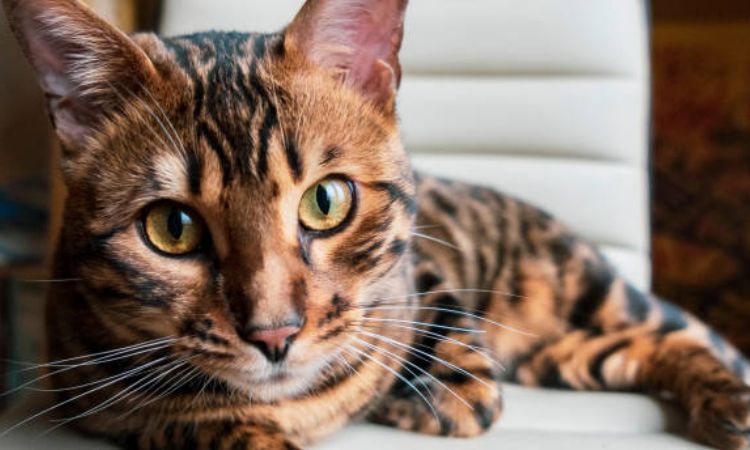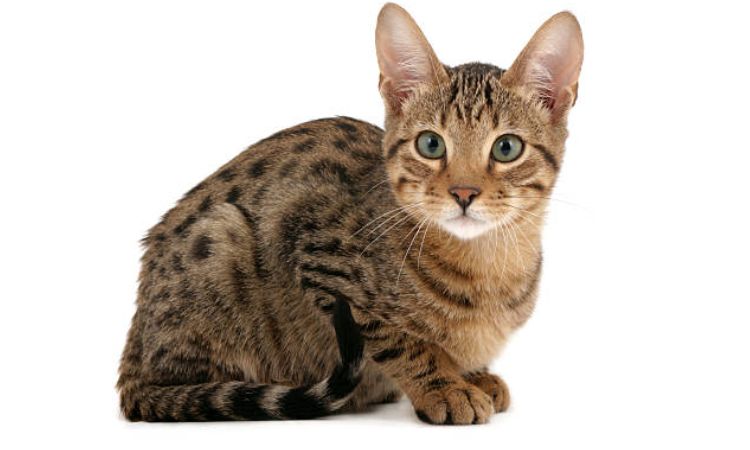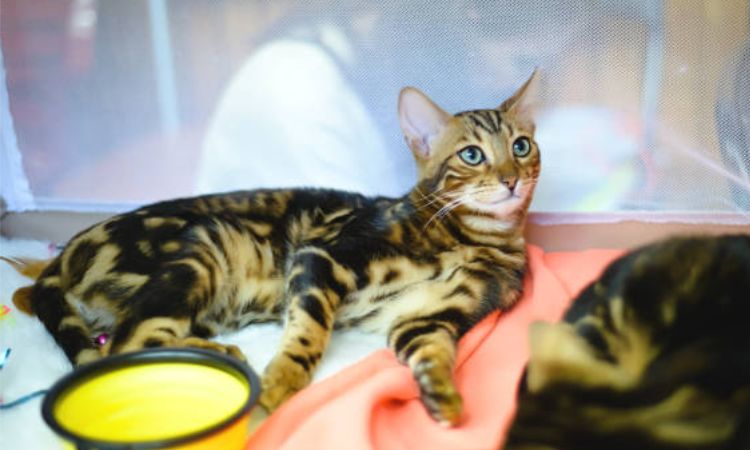Imagine a cat that moves like a miniature wildcat, with long, graceful legs, striking spotted fur, and ears that seem to listen to everything around it—meet the Serengeti. Born from the careful pairing of a Bengal and an Oriental Shorthair, this breed combines the elegance of the wild with the charm of a devoted companion.
In the following section, we’ll dive into everything you need to know about the Serengeti cat: from its price and size to personality traits, coat colors, and the defining characteristics that make it truly one-of-a-kind.
Serengeti Cat Appearance: A Domestic Serval

Size and Build
Weight and Height
Serengeti cats are medium to large in size, giving them an elegant yet athletic presence. Males generally weigh between 8–15 pounds (3.6–6.8 kg), while females are slightly smaller, typically 6–12 pounds (2.7–5.4 kg). Their height at the shoulder ranges from 12–14 inches (30–35 cm), which contributes to their long-legged, graceful stance. This size allows them to emulate the agile serval without being unwieldy as a domestic cat.
Physical Features
The Serengeti boasts a lean, muscular body with long legs and a slender, elongated neck, making them excellent climbers and jumpers. Their large, upright ears are rounded at the tips and set high on the head, enhancing both their alert expression and acute hearing. The overall frame is athletic and streamlined, emphasizing elegance and power while maintaining a domestic-friendly build.
Coat, Colors, and Markings
Coat Type
Serengeti cats have short, dense, and soft fur that lies close to the body. The coat is plush but easy to maintain, with minimal shedding compared to many other breeds. Regular weekly brushing is usually sufficient to keep the fur in pristine condition.
Accepted Colors & Patterns
A hallmark of the breed is the high-contrast spotted coat, which evokes the wild African serval. Recognized variations include:
- Golden to Tawny Spotted: Warm gold or tawny base with bold black spots spaced widely apart.
- Ebony Silver Spotted: Cool grey or silver base with contrasting black spots, giving a shimmering, “glittering” effect.
- Ebony Smoke: A darker base with subtle spotted patterns visible under certain lighting.
- Solid Black (Melanistic): Fully black cats may exhibit faint “ghost spots” in bright light, adding a touch of the breed’s wild ancestry.
The Serengeti’s coat pattern is a defining trait, balancing exotic appearance with domestic manageability.
Eyes and Head
Serengeti cats feature round, expressive eyes that can range from amber to gold, with occasional green tones. Their head is wedge-shaped, proportionally small but in harmony with their long neck and body. Large ears and bold eyes contribute to an alert, curious, and intelligent expression that complements their athletic frame.
Personality and Temperament
The “Velcro Cat”
Serengeti cats have earned the affectionate nickname “Velcro cat” due to their strong attachment to their human companions. They thrive on interaction, often following their owners from room to room and seeking out cuddles and attention. Their loyalty and affectionate nature make them particularly devoted pets, forming deep bonds with their family members while enjoying close companionship.
Activity and Intelligence
Serengetis are highly active and athletic, with a love for climbing, jumping, and exploring vertical spaces. Their long legs and agile build allow them to move with grace and precision, reminiscent of their serval-inspired appearance. In addition to their physical energy, they are exceptionally intelligent cats that require mental stimulation. Puzzle feeders, interactive toys, and structured playtime help keep their minds sharp and prevent boredom. Without adequate engagement, they may channel their energy into mischievous or destructive behaviors.
Vocal Nature
This breed is naturally expressive and “chatty”, a trait inherited from their Oriental Shorthair ancestry. Serengetis use a wide array of meows, chirps, and other vocalizations to communicate with their owners, often making their feelings and desires known in playful and endearing ways. Their vocal nature makes them highly interactive pets, eager to engage with those around them.
Suitability for Families and Other Pets
Serengeti cats are generally good with children and other household pets, including dogs that are comfortable around cats. Their playful yet gentle temperament allows them to thrive in family environments. However, due to their high energy levels and need for interaction, they are best suited to households that can provide regular playtime, mental stimulation, and plenty of companionship. A home that meets these needs ensures a well-adjusted, happy, and confident Serengeti.

Serengeti Cat Price and Breeder Information
How Much Does a Serengeti Cat Cost?
Serengeti cats are a relatively rare breed, and their price reflects both their unique appearance and careful breeding. Pet-quality Serengetis typically range from $600 to $2,000, depending on various factors. Show-quality cats or kittens with championship lineage may cost more.
Factors Affecting Cost
Several elements influence the price of a Serengeti cat:
- Lineage and Pedigree: Cats descended from well-documented TICA-registered lines or notable show cats often command higher prices.
- Show Quality vs. Pet Quality: Cats bred to conform closely to TICA standards and with excellent markings or features may cost more than a standard pet-quality Serengeti.
- Breeder Reputation: Reputable breeders who prioritize health, socialization, and responsible breeding practices often charge more, but this ensures a well-adjusted, healthy kitten.
- Location: Prices can vary by country or region, with cats in the US, Europe, or Australia generally more expensive than in other areas.
- Age: Younger kittens (8–12 weeks) are typically more expensive than older cats or adults.
Finding a Reputable Breeder
When looking for a Serengeti cat, it is essential to choose a TICA-registered breeder. The International Cat Association provides breed recognition, standards, and registration for developing breeds, ensuring ethical and responsible breeding practices. Reputable breeders will:
- Provide health guarantees for the kitten, including vaccinations and screenings for common issues.
- Offer information about the kitten’s lineage, temperament, and socialization.
- Ensure the cat has been raised in a loving, stimulating environment, preparing it for domestic life.
Avoid breeders who cannot provide documentation or who prioritize quantity over quality. Visiting the cattery, meeting the kittens and their parents, and asking detailed questions are all vital steps.
Adoption Options
While Serengeti cats are relatively rare, there are still opportunities to adopt a kitten or cat, particularly exotic-looking mixed breeds that resemble Serengetis. Rescue organizations and shelters occasionally receive cats with Bengal or Oriental Shorthair ancestry. Adopting from a rescue can be a rewarding option for those who want the Serengeti’s unique look while providing a loving home to a cat in need.
Even when adopting, it’s important to ensure the cat receives proper socialization, veterinary care, and enrichment to thrive in a domestic setting.
Care and Health of the Serengeti Cat
The Serengeti cat is an active, intelligent, and affectionate breed with a striking wild appearance but a fully domestic temperament. Proper care and attention ensure that these cats thrive both physically and emotionally in a home environment.

1. General Care and Environment
Housing and Living Space:
- Serengeti cats are highly energetic and curious, requiring plenty of vertical space such as tall cat trees, shelves, and window perches.
- While they can live happily indoors, secure outdoor access (balcony, garden, or enclosed catio) is ideal to satisfy their natural curiosity.
- They enjoy interaction with water, such as garden ponds or paddling pools, reflecting their Bengal ancestry.
Social Needs:
- Known as “Velcro cats”, Serengetis are highly social and develop strong bonds with their family.
- They thrive on daily interaction, playtime, and companionship, and may follow their favorite humans around the house.
- They are good with children and other pets if properly socialized, though younger children should be taught how to handle them gently.
2. Grooming and Coat Care
- Serengetis have short, dense, and soft coats, making them low-maintenance.
- Weekly brushing is sufficient to remove loose hair, maintain coat health, and provide bonding time.
- Despite their exotic look, they are not hypoallergenic, though shedding is minimal compared to other breeds.
- Pay attention to cleaning ears, trimming nails, and dental care, which are essential for overall health.
3. Nutrition and Feeding
- A high-protein, low-carbohydrate diet is essential to maintain their lean, muscular physique and high energy levels.
- Real meat or fish should be the main ingredient; avoid fillers or excessive grains.
- Due to their active metabolism, it may be better to provide smaller, frequent meals rather than one or two large meals per day.
- Ensure fresh water is always available to reduce the risk of urinary issues, which can be common in cats with high protein diets.
- Monitor their weight and adjust food portions as needed to prevent obesity.
4. Exercise and Mental Enrichment
- Serengeti cats are athletic and highly intelligent, requiring daily physical and mental stimulation.
- Provide interactive toys, puzzle feeders, and fetch games to engage their minds.
- Offer vertical climbing options, tunnels, and safe spaces for exploration to allow them to express natural hunting and climbing behaviors.
- Without adequate activity, they may display destructive or attention-seeking behavior.
5. Health and Veterinary Care
General Health:
- Serengetis are generally robust and healthy, benefitting from hybrid vigor.
- Life expectancy ranges from 9 to 15 years, depending on care and genetics.
Common Health Concerns:
- Dental Health:
- Susceptible to gingivitis, plaque, and periodontal disease.
- Regular tooth brushing and dental treats can prevent problems.
- Urinary Tract Health:
- Can develop urinary crystals or infections, especially if water intake is low.
- A diet supporting urinary health and plenty of hydration is essential.
- Digestive Health:
- Sensitive to sudden dietary changes or processed foods.
- Provide high-quality, consistent nutrition to maintain digestive balance.
- General Preventive Care:
- Routine vet check-ups, vaccinations, and parasite control are necessary.
- Monitor for weight changes, lethargy, vomiting, or unusual behavior, which may indicate health issues.
6. Breed-Specific Considerations
- Serengetis are active, intelligent, and vocal, requiring engagement from owners to satisfy their curiosity.
- They may attempt to open cupboards, turn on faucets, and explore cabinets, reflecting their cleverness.
- Their social nature makes them unsuitable for very quiet or low-interaction households.
Bringing a Serengeti cat into your home means welcoming an affectionate, intelligent, and highly active companion. Their long legs, striking spotted coat, and large expressive ears give them a wild, exotic appearance, yet they are fully domestic and deeply social. Serengetis thrive in homes that offer climbing opportunities, interactive play, and regular human companionship, making them an excellent choice for families and experienced cat owners alike. With their loyal “Velcro cat” personality, low-maintenance coat, and generally strong health, Serengetis perfectly blend beauty, charm, and playful energy in one remarkable breed.






